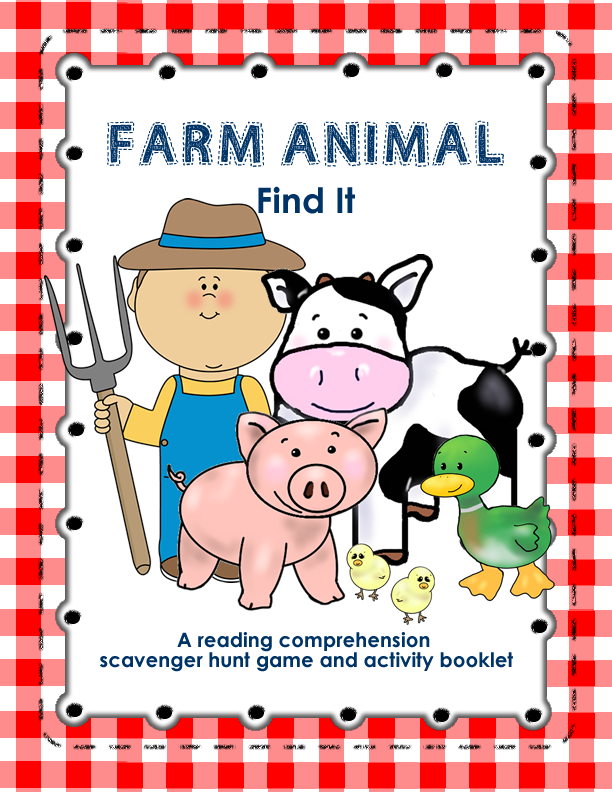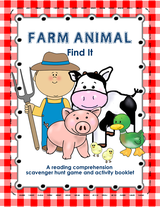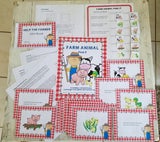Farm Animal Find It
SKU:
$3.50
$3.50
Unavailable
per item
Instant Digital Download
Get them up and moving with Farm Animal Find It reading comprehension scavenger hunt game. This colorful 18 page set includes matching sentence and picture cards, 60 stamps, a student record sheet, and an 8 page mini book that can be used as a follow-up activity or homework. The fun farm theme is perfect for your classroom and the cute character pictures help students decode words used in the game and mini book.
All assembly and teacher directions are included.
Covers nine common core standards for kindergarten, 11 common core standards for first grade, and 8 common core standards for second grade.
Get them up and moving with Farm Animal Find It reading comprehension scavenger hunt game. This colorful 18 page set includes matching sentence and picture cards, 60 stamps, a student record sheet, and an 8 page mini book that can be used as a follow-up activity or homework. The fun farm theme is perfect for your classroom and the cute character pictures help students decode words used in the game and mini book.
All assembly and teacher directions are included.
Covers nine common core standards for kindergarten, 11 common core standards for first grade, and 8 common core standards for second grade.
CCSS RF.2.4c -Use context to confirm or self-correct word recognition and understanding, rereading as necessary.
CCSS RF.2.4 - Read with sufficient accuracy and fluency to support comprehension.
CCSS RF.2.3c - Decode regularly spelled two-syllable words with long vowels.
CCSS RF.2.3b - Know spelling-sound correspondences for additional common vowel teams.
CCSS RF.2.3a - Distinguish long and short vowels when reading regularly spelled one-syllable words.
CCSS RF.2.3 - Know and apply grade-level phonics and word analysis skills in decoding words.
CCSS RF.1.4c - Use context to confirm or self-correct word recognition and understanding, rereading as necessary.
CCSS RF.1.4a - Read grade-level text with purpose and understanding.
CCSS RF.1.4 - Read with sufficient accuracy and fluency to support comprehension.
CCSS RF.1.3g - Recognize and read grade-appropriate irregularly spelled words.
CCSS RF.1.3e - Decode two-syllable words following basic patterns by breaking the words into syllables.
CCSS RF.1.3c - Know final -e and common vowel team conventions for representing long vowel sounds.
CCSS RF.1.3b - Decode regularly spelled one-syllable words.
CCSS RF.1.3 - Know and apply grade-level phonics and word analysis skills in decoding words.
CCSS RF.1.1 - Demonstrate understanding of the organization and basic features of print.
CCSS RF.K.3c - Read common high-frequency words by sight (e.g., the, of, to, you, she, my, is, are, do, does).
CCSS RF.K.3a - Demonstrate basic knowledge of one-to-one letter-sound correspondences by producing the primary sound or many of the most frequent sounds for each consonant.
CCSS RF.K.2d - Isolate and pronounce the initial, medial vowel, and final sounds (phonemes) in three-phoneme (consonant-vowel-consonant, or CVC) words. (This does not include CVCs ending with /l/, /r/, or /x/.)
CCSS RF.K.1c - Understand that words are separated by spaces in print.
CCSS RF.K.1b - Recognize that spoken words are represented in written language by specific sequences of letters.
CCSS RF.K.1a - Follow words from left to right, top to bottom, and page by page.
CCSS RL.2.7 - Use information gained from the illustrations and words in a print or digital text to demonstrate understanding of its characters, setting, or plot.
CCSS RL.2.1 - Ask and answer such questions as who, what, where, when, why, and how to demonstrate understanding of key details in a text.
CCSS RL.1.7 - Use illustrations and details in a story to describe its characters, setting, or events.
CCSS RL.1.1 - Ask and answer questions about key details in a text.
CCSS RL.K.10 - Actively engage in group reading activities with purpose and understanding.
CCSS RL.K.7 - With prompting and support, describe the relationship between illustrations and the story in which they appear (e.g., what moment in a story an illustration depicts).
CCSS RL.K.1 - With prompting and support, ask and answer questions about key details in a text.
CCSS RF.2.4 - Read with sufficient accuracy and fluency to support comprehension.
CCSS RF.2.3c - Decode regularly spelled two-syllable words with long vowels.
CCSS RF.2.3b - Know spelling-sound correspondences for additional common vowel teams.
CCSS RF.2.3a - Distinguish long and short vowels when reading regularly spelled one-syllable words.
CCSS RF.2.3 - Know and apply grade-level phonics and word analysis skills in decoding words.
CCSS RF.1.4c - Use context to confirm or self-correct word recognition and understanding, rereading as necessary.
CCSS RF.1.4a - Read grade-level text with purpose and understanding.
CCSS RF.1.4 - Read with sufficient accuracy and fluency to support comprehension.
CCSS RF.1.3g - Recognize and read grade-appropriate irregularly spelled words.
CCSS RF.1.3e - Decode two-syllable words following basic patterns by breaking the words into syllables.
CCSS RF.1.3c - Know final -e and common vowel team conventions for representing long vowel sounds.
CCSS RF.1.3b - Decode regularly spelled one-syllable words.
CCSS RF.1.3 - Know and apply grade-level phonics and word analysis skills in decoding words.
CCSS RF.1.1 - Demonstrate understanding of the organization and basic features of print.
CCSS RF.K.3c - Read common high-frequency words by sight (e.g., the, of, to, you, she, my, is, are, do, does).
CCSS RF.K.3a - Demonstrate basic knowledge of one-to-one letter-sound correspondences by producing the primary sound or many of the most frequent sounds for each consonant.
CCSS RF.K.2d - Isolate and pronounce the initial, medial vowel, and final sounds (phonemes) in three-phoneme (consonant-vowel-consonant, or CVC) words. (This does not include CVCs ending with /l/, /r/, or /x/.)
CCSS RF.K.1c - Understand that words are separated by spaces in print.
CCSS RF.K.1b - Recognize that spoken words are represented in written language by specific sequences of letters.
CCSS RF.K.1a - Follow words from left to right, top to bottom, and page by page.
CCSS RL.2.7 - Use information gained from the illustrations and words in a print or digital text to demonstrate understanding of its characters, setting, or plot.
CCSS RL.2.1 - Ask and answer such questions as who, what, where, when, why, and how to demonstrate understanding of key details in a text.
CCSS RL.1.7 - Use illustrations and details in a story to describe its characters, setting, or events.
CCSS RL.1.1 - Ask and answer questions about key details in a text.
CCSS RL.K.10 - Actively engage in group reading activities with purpose and understanding.
CCSS RL.K.7 - With prompting and support, describe the relationship between illustrations and the story in which they appear (e.g., what moment in a story an illustration depicts).
CCSS RL.K.1 - With prompting and support, ask and answer questions about key details in a text.


